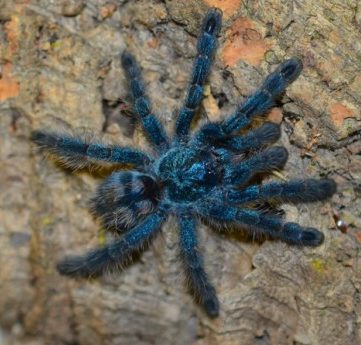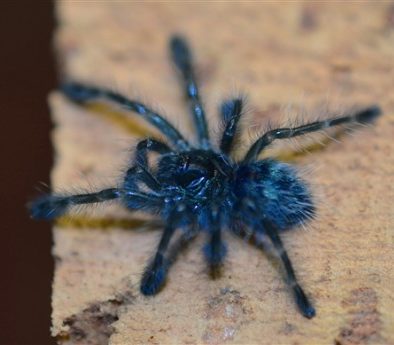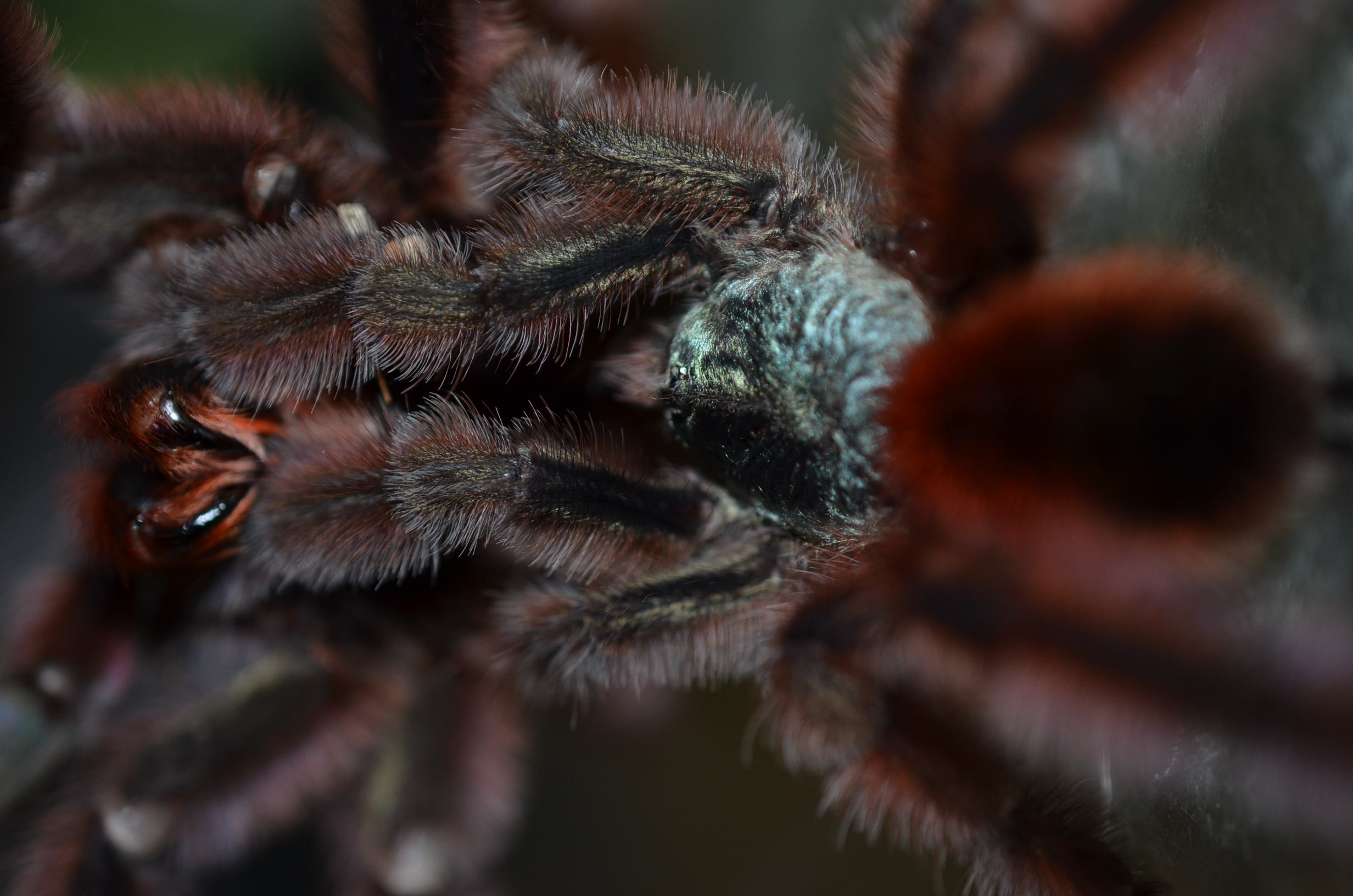Beautiful metallic blue spiderlings morph into multicolor adults sporting green, blue, red and purple hues with pink toes. This docile yet skittish species is not usually defensive and is a good first arboreal species.
Origin: New World. This tropical island tarantula is native to Martinique in the Caribbean.
Difficulty: Beginner to Intermediate (Depending on the size of the specimen)
Type: Arboreal
Adult Size: 4-6.5"
Growth speed: Medium to Fast
Longevity: Males 3-5 years, females 8-13 years
Temperament: Docile yet skittish. If agitated they may flee, drop urticating hairs and/or shoot feces with remarkable range and accuracy. Although it is uncommon C. versicolor can flick urticating hairs. Bites from this species are rare.
Bite potency: Mild
Urticating hairs: Yes
Ideal Temperature: 71 to 76°
Humidity: Medium to High

Fun Fact: One day many years ago a sparkling blue versicolor won over my heart and became my first tarantula. I was captivated by its remarkable color and the way it marched when it walked. The fuzzy blue spiderling would lift its legs high with every step, searching for something to climb up. This remarkable fuzzy blue animal looked to me like some enchanted creature spun with magic yarn. "Linux" was maybe about 1.5-2" when I acquired him and two years later molted into a puny 3.75" mature male, still to this day the smallest mature versicolor I've ever seen. He successfully bred with females twice his size but sadly the females molted. Although he never produced any babies I will never forget how my first tarantula filled me with awe and wonder.
Interesting Fact: Although I rarely see females above 6-6.5" or so I once had a remarkable female with a 7.1" legspan.
Enclosure: As an arboreal (tree dwelling) tarantula this species will require an enclosure that is taller than it is long. The enclosure must be well ventilated to prevent the growth of mold and mildew, but not so much the enclosure dries out too quickly.
The arboreal species will want to web high in the enclosure, and typically at the top so be sure to provide objects higher up in which the tarantula can use to grab onto and make a home.
It is ideal for an arboreal tarantula enclosure to open from the side or middle instead of the top. If the opening is on top the webbing will most likely be damaged every time the enclosure is opened. This can be quite stressful and problematic for a pet spider.
 For small spiderlings under about 1 1/4" we recommend the Arboreal Spiderling Enclosure Kit. For specimens over 1 1/4" to about 2 1/2" we recommend the Arboreal Juvenile Enclosure Kit. Specimens over 2 1/2" and under about 5 1/4" can go into a 7x7x11" Adult Complete Arboreal Enclosure Kit. I keep many of my C. versicolor breeding females in the 7x7x11" Complete Arboreal Enclosure while my larger females over about 5 1/4"-5 1/2" or so are housed in a 8x8x14" Adult Complete Arboreal Enclosure Kit. If you have a larger specimen or would like to be sure the final enclosure is definitely large enough we recommend the 8x8x14" Adult Complete Terrestrial Enclosure Kit as a good choice for a permeant enclosure for 2 1/2" and over specimens. Click HERE to find out how to you measure a tarantula.
For small spiderlings under about 1 1/4" we recommend the Arboreal Spiderling Enclosure Kit. For specimens over 1 1/4" to about 2 1/2" we recommend the Arboreal Juvenile Enclosure Kit. Specimens over 2 1/2" and under about 5 1/4" can go into a 7x7x11" Adult Complete Arboreal Enclosure Kit. I keep many of my C. versicolor breeding females in the 7x7x11" Complete Arboreal Enclosure while my larger females over about 5 1/4"-5 1/2" or so are housed in a 8x8x14" Adult Complete Arboreal Enclosure Kit. If you have a larger specimen or would like to be sure the final enclosure is definitely large enough we recommend the 8x8x14" Adult Complete Terrestrial Enclosure Kit as a good choice for a permeant enclosure for 2 1/2" and over specimens. Click HERE to find out how to you measure a tarantula.More information on how to build & maintain an Arboreal Spiderling Kit for C. versicolor:
Arboreal Spiderling Kit Set-Up: C. versicolor Part I
Arboreal Spiderling Kit Set-Up: C. versicolor Part II
Substrate: Cocofiber, vermiculite, peat moss and/or potting soil (or a mix) are all excellent substrate choices. Please make sure the substrate you choose is organic and chemical/fertilizer free. Do not use sand, pebbles, rocks or wood chips or anything else that could potentially cut or injure the tarantula.
Water: C. versicolor loves to drink the "dew" off the sides of the enclosure following a light mist. Keep in mind arboreal species are typically much more sensitive to dehydration than the more commonly kept terrestrial scrubland & desert species. This does not mean the enclosure should be sopping wet as this can lead to other potential problems such as mold & mildew. There is a "sweet spot" that sometimes can be hard to find for beginners. This is why smaller C. versicolor are recommended for intermediate and above keepers. Larger specimens are harder to come by but are more tolerant of a wider range of conditions. I recommend keeping one corner of the enclosure misted, especially if there is no water bowl.
Arboreal tarantulas about 1 1/2-2” and over can, and depending on the situation can possibly benefit from being provided with a shallow water dish in order to drink. The water bowl should be rinsed our every time it is refilled.
Feeding: Adults will eat every 5-12 days depending on the size of the spider and it's prey. Spiderlings should eat more often, every 4-7 days. Adults may be fed crickets, mealworms or roaches. Spiderlings under .75” can only eat food small enough for it to overpower. This includes pinhead crickets, flightless fruit flies & freshly hatched "pinhead" rusty red roaches. It is not advised to feed your tarantula wild-caught food. It could contain parasites or pesticides that could be fatal to your pet. Keep your tarantulas enclosure clean. food waste left in the enclosure will invite mold, mildew, mites, flies and other pests. It is advised to remove uneaten prey items after a few hours. If using a feeder who will not “bother” a tarantula such as dubia roaches it is alright to leave them in the enclosure as long as they are not causing stress to the specimen. A more detailed feeding, misting & troubleshooting guide can be found here: https://jamiestarantulas.com/guides/






Leave a Comment - Reply to